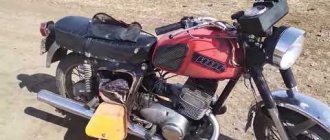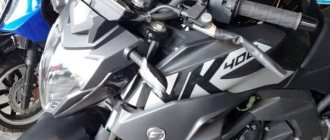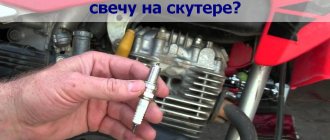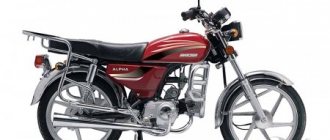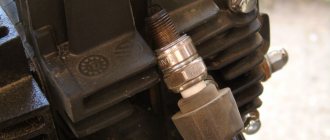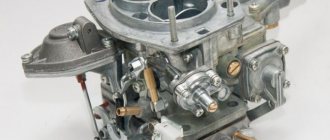In most cases, detection of fuel in the wrong place is a consequence of some other malfunction. In this case, the vehicle may stop starting altogether. The appearance of gasoline in the air filter occurs under the following circumstances:
- during the last trip I fell into a hole;
- the driver forgot to turn off the ignition at night;
- there is a loss of traction, especially at low speeds;
- a decrease in dynamic characteristics, which is especially noticeable when using 50 cc scooters, since they have no power reserve;
- gasoline flows from the carburetor drain hole, both when idle and when driving;
- drops in speed when sharply squeezing the gas handle or accelerator pedal, which is especially noticeable when driving in a traffic jam at a traffic light;
- the gas distribution unit or fuel system, for example, a carburetor, was repaired;
- the engine was running on an over-enriched mixture.
Significant mileage can also cause gasoline to get into the air filter. Physical wear of metal and gaskets leads to the creation of conditions for the occurrence of this malfunction. However, in this case, the engine will gradually start worse and worse, and the strong smell of gasoline from the air filter of a motorcycle or car will not allow the car owner to ignore the breakdown.
Causes of malfunction
You can determine that the carburetor is overflowing by several signs:
- Condition of the candle. A dirty spark plug indicates a rich fuel mixture, which means high gasoline content. Even a serviceable or new spark plug may not be able to cope with the flow of fuel entering the cylinder and over time it will become covered with soot, will be constantly wet and the engine will stop starting.
- Gasoline leaks through the air filter. Signs of fuel may be found in the air filter housing.
- Gasoline leaks through the float chamber gasket.
It is worth noting that these signs can appear either on their own or after repairs. For what reasons can the carb overflow?
Failure of the fuel valve
The tanks are equipped with vacuum fuel taps with three outlets. One of them is taking fuel from the tank, the other is supplying fuel to the carburetor. The third outlet is intended for supplying a vacuum hose. When a vacuum is created in the engine, the valve membrane begins to pump fuel.
Advice! If the engine does not start after a long period of inactivity (fuel is not pumped in), in order not to wait for the engine to pump it in, you can remove the vacuum hose on the other side of the tap and create a vacuum with your mouth until the carburetor is filled.
Clogged air filter
If there is insufficient air supply, the scooter may also overflow fuel. You can diagnose the filter for air permeability as follows. Simply disconnect the air filter. If the engine now starts to work correctly, then it is necessary to change the air filter. When the carburetor on a scooter without a filter still floods, “dig deeper”!
Locking needle
Briefly about the principle of operation of the float chamber. Fuel enters it, thereby raising the float. The float, rising, lifts the locking needle behind it. When there is enough fuel in the chamber, the shut-off function closes the fuel supply hole.
If the shut-off needle is worn out (the tip or metal body is worn out), then it cannot completely close the supply hole and gasoline continues to flow. The same effect occurs if a speck (grain of sand) gets under the locking needle.
Cleaning the foam filter
In short, let's get started.
Let's start by removing the filter. Often, in order to reach the filter, you need to unscrew the seat and part of the plastic body kit. Before removing the filter cover, you need to make sure that there are no deposits of dirt, sand or dust in the filter housing that may have entered the intake distributor during dismantling. If there is, it needs to be cleaned before removing the filter. We remove the filter and look into the air intake. It's great if you can see the carburetor directly. We are looking for dust deposits and dark deposits on the carburetor diffuser, which indicate that the air is not being cleaned well. At the next stage, after inspecting the intake tract, you should plug it with a rag (which does not leave lint and does not unravel into strings, well, it’s clean, of course) or a special lid. Since the next step in order will be cleaning the inside of the air filter housing, you need to be sure that nothing gets into the middle of the intake pipe. Why do you need to clean the air filter box? The cleaner it is, the slower the cleaned (new) filter will clog, and the box itself is also a good dust collector, especially if a crankcase exhaust is connected to it, due to which an oily deposit forms on the walls of the air filter housing. It would be advisable to clean all this with a cloth soaked in gasoline or white spirit. When working with white spirit and other solvents, it is good to use glasses, gloves and work in a well-ventilated area!
Now the fun part begins, which is actually cleaning and washing the removed foam filter.
There are a lot of specialized motorcycle chemicals for servicing filters, but a significant part of it is not approved for use in Europe due to toxicity and, accordingly, may not be officially supplied to our country. Some similar kits even come with a branded washing bucket, but considering the price products like this, I wouldn’t want to go bankrupt servicing the filter. But it needs to be serviced constantly, and no tuning bucket will reduce its dirtiness. That's why smart scooterists choose white spirit! It is prohibited to use gasoline, as there is a danger of affecting the glued seams of the air filter, and even more so, more aggressive solvents, which can directly turn foam rubber into glue, are not suitable. You need to purchase your own plastic bucket with a sealed lid and store a couple of liters of white spirit in it just for flushing purposes. This cleaning is rough and preliminary, so a couple of liters filled in is enough for repeated use.
You need to put something like a grate on the bottom of the bucket. This is so that the washed dirt particles quietly fall into the sediment and remain there without rising to the top, catching them with the filter when washing.
Trouble-shooting
What to do if you had to face such problems? Let's go in order. You need to start with the air filter - if there are no problems with it, then proceed to the next steps.
Fuel tap problem?
If gasoline constantly flows from the fuel supply hose, even when the vacuum hose is removed, then the valve is faulty. It simply does not work, but is always in the open position. In this case, the tap must be replaced with a new one.
If, when you remove the vacuum hose, gasoline stops flowing, then the reason is a constant vacuum - you need to climb into the cylinder head.
Locking needle
Provided the faucet is in good working order, you can play the shut-off game. How to get to the needle of a scooter or moped?
- To remove the carburetor, you need to disconnect the air filter; hoses suitable for it; unscrew it from the intake manifold and remove the throttle cable.
- Next, use a Phillips screwdriver to remove the float chamber housing.
- Assess the condition of the shut-off needle and float antennae.
- If necessary, replace the needle and bend the float antennae. If the needle is in good condition, then its seat should be thoroughly washed and blown out.
- Reassemble everything and install it on the engine.
Vacuum accelerator (if all else fails)
In addition to the locking needle, Chinese scooters are also equipped with a vacuum needle (vacuum accelerator). This device also works from a vacuum hose connected to the “carb”. This needle has 5 (usually) adjustment positions. When the scooter accelerates, the vacuum opens this needle and more fuel is supplied to the combustion chamber.
The system is correct, however, everything breaks down. Over time, none of the needle positions produces results. This problem can be solved simply by removing or cutting the vacuum hose (not the one to the fuel tap)! And the engine no longer overflows - miracle of miracles.
How to change it correctly?
How to change the air filter on a Chinese moped? The sequence of actions for replacing the cleaning device in a moped is quite simple.
Instructions for DIY replacement steps:
First of all, we install the moped on the stand. It is also advisable to wash the moped to prevent dirt from getting into the moped components; Now you can start replacing: remove the protective cover of the battery; to do this, you need to unscrew one bolt with a Phillips screwdriver; Then we disconnect the battery from the terminals and take it out of the seat; Next, you need to remove the seat; to do this, you need to unscrew two bolts with a “10” key and move it with a sharp movement (from left to right in the direction of travel of the moped); As soon as the seat has moved, we lift it and it can be easily removed. Pull the clamp off the air filter pipe. If yours is not rubber, but metal, you must first loosen it; Now you can pull the pipe off the carburetor. This must be done carefully to prevent dirt from getting inside the carburetor; After the pipe has been disconnected from the carburetor, we pull it inward to the place where the battery was. The air filter housing is made of rubberized material, so it can only be deformed when removed, only carefully. Deforming the filter casing, carefully pull it
This should be done extremely carefully, as you can touch and break the wires passing nearby; After successfully removing the casing, remove the filter from it. If there is dust or dirt in the casing, it is necessary to wash and dry it; Now install the filter and reassemble in reverse order.
Read more: How to view the password in the Odnoklassniki application
Before installing the seat and battery cover, make sure you have not cut or disconnected any wires during installation.
Causes of a malfunction associated with gasoline in the air filter
When using scooters, not all owners think about the quality of the fuel poured into the gas tank. Gas stations skimp on timely replacement of filter elements, so the quality of gasoline will not meet the standards. This is especially noticeable in places remote from megacities.
Debris gradually moves from the gas tank through the fuel system and into the carburetor. If a small grain gets under the shut-off needle, it will not allow it to take its place and will cause an overflow of fuel in the float chamber. After leaving the carburetor it will end up in the filter element.
Also, the reason why gasoline pours out may be excessive wear of the needle or physical aging of the membrane. With a long mileage, abrasion of the metal and its deformation are observed. The needle may get stuck or not close properly. In the case of a membrane, its long-term operation leads to its breakthroughs. In this case, particles of the ruptured membrane can interfere with the normal movement of the locking needle.
There may also be gasoline in the air filter due to the owner’s inability to correctly adjust the screw responsible for the idle speed of the motorcycle. Maximum twisting of it leads to operation on an over-enriched mixture and excessive fuel consumption. Having examined the spark plug of such a scooter, you can find black carbon deposits.
If the carburetor throws out fuel only after starting, the reason may lie in a malfunction of the pre-start enricher or vacuum valve. To successfully start the engine, a mixture with a high gasoline content is supplied at the first moment. The enricher may supply too much fuel, causing the air filter to flood. Loss of elasticity of the vacuum valve membrane can result in too much flammable mixture entering the float chamber by gravity. If additional pre-injection occurs, gasoline will enter the air filter.
First filter
Link to filter: First filter There is also a shortened version: beep
I will start my review of the most massive and most versatile filter. Its versatility lies in the fact that the kit comes with three adapters for a hose with an internal diameter of 6 mm, 8 mm and 10 mm. The outer diameter of the adapter for a 6 mm hose is 6.3 mm, for an 8 mm hose is 8.1 mm, for a 10 mm hose is 9.5 mm. The filter housing is aluminum with a glass bulb.
The filter consists of eleven parts: two adapters, two side covers with rubber seals in each, a hollow pin in the center, a filter element, a filter element retainer with a rubber sealing ring and a glass bulb. By the way, the glass of the flask is very thick, the thickness of the glass is 2.7 mm (photo in the spoiler just below). In the next photo you can see all this. You can’t see all of them in the photographs, but there are 4 holes in the tube, two on one side and two on the other, it may seem that the tube is hollow and gasoline simply flows through, without filtration, but in the center the tube
Since the filter is completely disassembled, the pin must be oriented correctly when assembling it. Otherwise, the filter turns into a plug. In order to better imagine the quality of the materials, I will provide photographs of some parts of the filter. And I'll start with the filter element.
The length of the filter with installed adapters is 122.7 mm, and the weight is 49.2 g.
Other sizes
Troubleshooting Methods
Most often, if fuel leaks from the filter, owners rush to change the carburetor. The mistakes of this approach to repair are:
- gasoline may enter the air filter not only due to the fault of the carburetor, so replacing it with a new one may not eliminate the problem;
- ridding the float chamber of debris is not a labor-intensive process and is carried out without resorting to financial costs;
- revising the settings of the quality and quantity screws can eliminate the malfunction without dismantling the carburetor.
Therefore, to correct the problem, it is recommended to adhere to the following action plan:
- If there has been interference with the idle speed or mixture settings, check that they are set correctly;
- Check the operation of the vacuum valve. When closed, fuel should not pass through;
- Check the electronic starter enrichment. After turning it off, you need to test run the engine;
- Remove the carburetor and disassemble it;
- If no significant wear, deformation, or damage is visible, blow it out. If plaque or fallen resins are visually detected, the float chamber will need to be flushed;
- Some fuel system designs include a reed valve. It has low maintainability, especially when made of metal. If any bent is found, it is recommended to replace it with a new one.
It is necessary to change the carburetor only if it begins to throw fuel due to excessive wear. In this case, the vehicle has a solid mileage on the odometer and gasoline begins to be thrown into the air filter not unexpectedly, but gradually with increasing volume. Initially, you can only notice the smell, but over time the amount of fuel in the filter can reach 100 - 150 grams.
The most unpleasant situation is when the valve burns out and excessive pressure occurs, pushing fuel into the filter. This situation happens extremely rarely, but you shouldn’t discard it when looking for a breakdown. For diagnosis, it is enough to measure the compression. If its value is low, the engine should be repaired.
Preventing Breakage
The sudden appearance of gasoline in the filter after visiting a gas station indicates dirty fuel. You should stop visiting unverified stations. It is also not recommended to buy fuel while replenishing the storage tank, as the flow from the fuel truck pipe lifts all the debris from the bottom of the tank.
When performing adjustment work, you should mark the positions of the mixture quality and quantity screws. To do this, you need to tighten the bolt completely, counting the revolutions. In case of subsequent unsuccessful setup, knowing the preset value, it will be much easier to return to the original state.
Driving should be as careful as possible. Any drop of the scooter may cause damage to the fuel system. Also, rust that comes off due to dynamic load can fix the locking needle, preventing it from taking the required position.
Whatever the reason for the appearance of gasoline in the filter, you should not delay troubleshooting. Operating the engine in such conditions leads to excessive wear of all parts, which increases the need for major repairs. A quick response to the first symptoms of malfunction of the fuel system will save the owner’s wallet from unnecessary waste.
Reasons for the appearance of gasoline in the air filter
In most cases, detection of fuel in the wrong place is a consequence of some other malfunction. In this case, the vehicle may stop starting altogether. The appearance of gasoline in the air filter occurs under the following circumstances:
- during the last trip I fell into a hole;
- the driver forgot to turn off the ignition at night;
- there is a loss of traction, especially at low speeds;
- a decrease in dynamic characteristics, which is especially noticeable when using 50 cc scooters, since they have no power reserve;
- gasoline flows from the carburetor drain hole, both when idle and when driving;
- drops in speed when sharply squeezing the gas handle or accelerator pedal, which is especially noticeable when driving in a traffic jam at a traffic light;
- the gas distribution unit or fuel system, for example, a carburetor, was repaired;
- the engine was running on an over-enriched mixture.
Significant mileage can also cause gasoline to get into the air filter. Physical wear of metal and gaskets leads to the creation of conditions for the occurrence of this malfunction. However, in this case, the engine will gradually start worse and worse, and the strong smell of gasoline from the air filter of a motorcycle or car will not allow the car owner to ignore the breakdown.
Problems when paying with bank cards
Sometimes difficulties may arise when paying with Visa/MasterCard bank cards. The most common of them:
- There is a restriction on the card for paying for online purchases
- A plastic card is not intended for making payments online.
- The plastic card is not activated for making payments online.
- There are not enough funds on the plastic card.
In order to solve these problems, you need to call or write to the technical support of the bank where you are served. Bank specialists will help you resolve them and make payments.
That's basically it. The entire process of paying for a book in PDF format on car repair on our website takes 1-2 minutes.
If you still have any questions, you can ask them using the feedback form, or write us an email at [email protected]
Debris that can cause gasoline to enter the air filter
The main sources of debris in the fuel system are:
- gasoline filled at an untested station, especially immediately after the fuel truck has left;
- rust from the inside of the tank, for example, coming off after hitting the gas tank;
- carburetor gasket elements crumbling due to physical aging;
- dirty fuel filter;
- the external environment, or rather a careless attitude towards the refueling process, when foreign debris gets into the gas tank.
This problem is especially relevant for scooters and motorcycles not equipped with fuel filters.
The debris, following into the carburetor, falls under the shut-off needle located in the float chamber. As a result, it does not descend into its seat and is not able to block the fuel channel.
To correct the problem, you need to disassemble the carburetor. After removing the float, remove the needle and put it in a dust-free place. Using compressed air, you need to blow out the carburetor. When reassembling the fuel system, it is important to protect it from debris, otherwise gasoline will end up in the air filter again.
To facilitate diagnostics, if possible, you can install a similar carburetor on your vehicle. If gasoline gets into the air filter even with a new unit, you should continue troubleshooting without wasting time disassembling the carburetor.
Cleaning and replacing the fuel filter on a scooter
The fuel filter should be located in the line gap between the gas tank and the carburetor. If the scooter is equipped with a fuel pump, as, for example, on most Honda scooters, the filter must be connected in the gap between the tank and the pump.
The gasoline filter on a scooter can be disposable or reusable. As is initially clear, a disposable element simply needs to be replaced with a new one after a certain mileage, while a reusable element can be disassembled, cleaned and used again. As practice shows, it is advisable to use a disposable fuel filter for motor vehicles (it is somewhat smaller than that for a car). Its cost ranges from less than $1, so there is no point in bothering with the maintenance of more expensive dismountable filters.
Some Japanese scooters are equipped with dismountable filter elements that have a regular place in the space under the seat or under the floor. The filter needs to be looked for near the gas tank, this is obvious. Any standard collapsible element can always be replaced with a disposable one if there is no desire to regularly maintain it.
Scooters equipped with metal gas tanks are more likely to develop rust particles or old peeling paint in the fuel tank, however, if the scooter has not been used for a while and has been stored with an empty tank
In other cases, no matter what kind of tank your scooter is equipped with, regularly replacing the fuel filter will allow you not to worry about dirt in the gasoline, as well as, in fact, that the filter is clogged and cannot pass enough gasoline
The last factor can often manifest itself at speed, when when adding gas, symptoms of a lean mixture and jerking are clearly visible.
The fuel filter on a scooter can be replaced even by a person who has no experience in repairing such equipment. To do this, you need to loosen the fastening clamps on the hoses, place a dry rag under the breaks in the line (to avoid fuel spills), then remove the filter. The new filter is installed in place, taking into account the direction.
Any filter element, regardless of cost, has a fuel direction designation on the body. To ensure proper operation of the filter, it must be installed in the line with an arrow in the direction from the tank to the carburetor. After tightening the clamps, the scooter is ready for use.
You can also read other articles on the topic:
Vacuum valve does not hold
The reason why gasoline ends up outside its main path may lie in the vacuum valve. An electronic valve prevents gravity flow and excessive gasoline pressure.
To diagnose the malfunction, it is necessary to disconnect the valve from the main network and power it directly from the battery.
IMPORTANT: The valve must first be checked with a multimeter or meter for short circuits. Otherwise, the battery may be damaged and electrical injury may occur.
Chinese scooters are equipped with non-repairable vacuum valves. Repair is carried out by replacing the failed component with a new one. More serious devices use a split housing. In this case, repairs may be limited to a visual inspection of the diaphragm with a decision to replace it.
The locking needle is worn out and does not perform its functions
Due to a worn needle, gasoline enters the air filter in the same way as in the case of debris in the carburetor. The symptoms are similar in both cases. Blowing and flushing the carburetor can slightly improve engine performance, but fuel will be thrown into the air filter with the same force.
Diagnostics and inspection of the condition of each element can eliminate the reason why fuel appears in the filter element. In the future, a decision is made to replace components or purchase a new carburetor.
The membrane has leaked and is leaking fuel.
The reasons that caused the appearance of holes in the membrane and, as a result, the appearance of fuel in the air filter may be:
- natural wear and tear of the membrane and its physical aging;
- mechanical damage caused by unprofessional repairs;
- Road accident or extreme driving.
A symptom of membrane damage is deterioration of vacuum in the intake manifold and air filter. There is a gradual deterioration in the technical characteristics of the car. It may take more than one month before the iron friend finally stalls.
To determine whether fuel is leaking through the membrane, it is necessary to disassemble the carburetor. Diagnostics is performed by visual inspection.
To repair, you will need to replace the membrane with a new one. Before replacing, you should bleed the carburetor to prevent debris from getting into the jets or under the shut-off needle.
Idle settings are off
Often, manufacturers of scooters, motorcycles and other inexpensive equipment recommend that owners independently adjust the carburetor by adjusting it with the idle speed screw.
As a result of the screw being fully tightened, the carburetor ejects fuel and it flows into the air filter.
Adjusting the carburetor will completely eliminate the problem.
Lack of air causes operation on a rich mixture, which leads to unstable engine speed. This malfunction can also be diagnosed by the condition of the spark plugs.
When to check your work?
Let's figure out in what cases it is necessary to check the operation of the scooter. For this you need:
periodic checks, cleaning, replacement of parts
With them, attention is directed to brittle, fragile parts; regular – parts sensitive to blockages. Dirt on them can lead to engine failure, overheating or jamming;
Maintenance leads to an extension of the life of motorcycle equipment
- current - when a violation is detected: rupture of connecting tubes, leakage of oil and the presence of stains from it, as well as cracks due to the influence of precipitation and temperature on the plastic;
- Preventive checks when changing oil, refueling, cleaning from dirt. Ignition and braking systems are also checked.
Preventive inspections and measures taken to replace unsuitable parts are important:
- fuel pump,
- gas tank,
- gasoline tap,
- fuel filter,
- air filter,
- carburetor,
- connecting tubes.
You can check the functionality of the fuel pump yourself.
Incorrect operation of the starting enrichment
If gasoline enters the air filter only when the engine is started, you should pay attention to the starter enrichment solenoid valve. Diagnosis is made in two ways:
- 1 Powering the valve directly from the battery;
- 2 Starting the engine when the power supply to the starting enrichment is turned off.
In the first case, diagnostics are performed similarly with a vacuum valve. In the second case, the start will be on a lean mixture, so if fuel is pouring into the filter, then the reason does not lie in the solenoid valve and the search goes further.
How to change the fuel filter on a scooter?
The fuel filter is a standard part on scooters with a separate lubrication system. The main purpose of the fuel filter is to protect the carburetor and the engine itself from foreign particles (dust, dirt, sand, etc.) that can get into the fuel, and with it into the engine.
It is worth noting that scooters, depending on the model and manufacturer, can use disposable and reusable filters. A disposable filter is a consumable element of the fuel system, which after a certain period of operation is replaced with a similar new one. As for the reusable filter, it is quite simple to disassemble and clean it, after which it is suitable for further use.
The experience of many scooter owners shows that it is more practical and convenient to use disposable fuel filters, since their cost is low, they do not require disassembly and cleaning (the filter is easy enough to change) and they can be installed instead of a standard reusable filter on any scooter.
The fuel filter, depending on its type (reusable or disposable), should be changed or cleaned every 10 thousand kilometers. In addition, it is recommended to change or clean the fuel filter if the scooter has not been used for its intended purpose for a long time. However, the fuel filter may fail before the scheduled replacement date. How to understand that he is no longer coping with his main task? You will feel this in the behavior of the scooter while driving - fuel filter problems are expressed in jerks. Similar symptoms can be observed when operating a scooter on low-quality fuel.
Where is the fuel filter located? On most scooter models, the fuel filter is usually located in the section of the fuel line between the gas tank and the carburetor. However, there are exceptions - on scooters with a fuel pump, the filter may be located between the gas tank and the gas pump. In particular, this is the location of the fuel filter found in Honda scooters. Typically, the fuel filter is located under the seat, or under the floor of the scooter - not far from the gas tank.
Fuel filter replacement sequence:
Pull the section of the fuel hose with the fuel filter out so that you can freely carry out all the necessary manipulations. Next, you need to use a screwdriver to loosen the clamps on the fuel hoses that connect to the filter. It is worth noting that the fuel filter is not always secured with clamps. Sometimes steel wire clamps are used instead. If possible, place some container or rag under the place where the fuel filter is located, since gasoline may spill out of the hoses during the process of removing the filter. Now the filter can be removed - cleaned (if it is a reusable filter) or replaced with a new one
When installing a new filter, pay attention to the direction in which it should face. Typically, this direction is indicated by an arrow on the filter housing itself.
It is worth remembering that this arrow indicates the direction from the fuel tank to the carburetor. Now you need to tighten the clamp. Then you need to start the scooter and make sure that there are no leaks in the fuel filter area, after which you can safely ride.
Carburetor petals and fuel return
When the piston moves from bottom dead center, fuel initially rushes back into the carburetor. On high-speed engines, most often used on motorcycles, a reed valve is used to prevent the air-gasoline mixture from escaping. Valves are:
- metal, characterized by low reliability;
- carbon, expensive, but rarely fail.
Garage craftsmen advise bending the valve petals if it fails. Practice shows that this is only a temporary measure and repairs with replacement of petals are not far off.
Diagnosis is performed by visual inspection. The presence of burnouts or thermal damage or twists indicates the need to purchase a new reed valve.
Despite the unexpected appearance of fuel in the air filter and the inability to start the engine, during operation you should listen to your bike, scooter, or car. Minor malfunctions in engine operation should alert the owner so that in the future he does not see the air filter pouring gasoline onto the ground.




